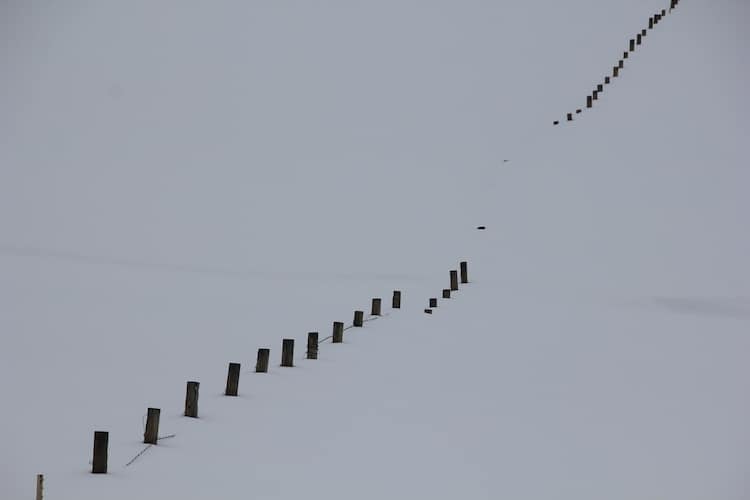Some say the deep snows in northwestern Colorado are unlike anything they have ever seen. What will it do for Powell and Colorado River?
by Allen Best
During early March I traveled to Colorado’s Yampa Valley to see, hear, and feel what a big-snow winter looks like and to ponder the implications for the Colorado River. This has been an epic winter, both wondrous and awful.
Ranchers in that valley have long measured snow depths against three-wired stock fences. In Steamboat Springs and along flanks of the Park Range, it’s three wires and more. Nearing Hahns Peak, only dimples in the snow marked the tops of fence posts.
Along the Wyoming-Colorado border, rancher Patrick O’Toole reported that this has been the hardest winter since he arrived in 1976. That includes 1983, when snowstorms persisted until June, catching Colorado River water managers flat-footed. Gargantuan flows into Lake Powell nearly ruptured Glen Canyon Dam.
“This year is more,” said O’Toole.

Craig remained in the icy fastness of winter on March 5, while near Steamboat Springs, above, snow nearly obscured a fence at the foot of Rabbit Ears Pass. Photos/Allen Best
O’Toole’s family operation moved 7,000 head of sheep from winter range north of Craig to more hospitable desert range. The deep snow, cold, and winds that seem to be worsening were too much for his woolies. He told of pronghorn antelope left behind, some just lying along roads, too weak to stand.
“And there’s a lot of winter left,” he said.
In Craig, walls of icicles hung from roof edges, and the motel parking lot had snow and ice a half-foot thick. Along the edges of the frozen Yampa River, six cow elk huddled, looking perplexed, as another storm moved in. Glancing at my phone, I saw that in Denver, the temperature was near 50. In the opposite corner of Colorado, Lamar had been warned of potential prairie fires.
While examining this snow-covered landscape, I thought often about Helen Henricks Perry. In the early 1980s, the late Ed Quillen and I had written a story about a family that in 1904 had traveled from Nebraska and homesteaded at about 9,000 feet in elevation at the headwaters of Troublesome Creek, at the foot of the Rabbit Ears Range northeast of Kremmling.
But the Henricks family lived in a place that is remote even during summer months. And the winters were long. Helen told us that one of the happiest days of her life occurred after she had moved to Kansas City and it snowed. The next morning, she got up and the snow melted.
Driving twisting, snow-covered county roads made me tense, but the whitened landscapes blanketed by snows filled me with joy. My mind’s ears erupted in the “Hallelujah Chorus.”
The Steamboat ski area surpassed last season’s total snowfall in mid-January. In the town itself, banks of carefully placed snow head-high and taller form a labyrinth of slots and passages, the city’s streets, sidewalks and driveways. Gary Suiter, the city manager, told me that the snowbanks we saw along city streets had shrunk considerably from a month before. Mindful that spring will eventually arrive, his city crews have already ordered sandbags.

The snowpack in Steamboat Springs had settled by early March, although it was still head-high or taller along some city streets and at the base of Mt. Werner. Photo/Allen Best
Nobody can know for sure when melting will begin in earnest. Along the Elk River, north of Steamboat, Jay Fetcher has faithfully recorded the day each year that the final snow on his pasture melts. His father began the records in 1949. The “snow off meadow” date varies, as do the snowpack and temperatures, but has arrived on average one day earlier every five years.
Will this epic snowpack end the drought, fill Lake Powell, and cause Colorado River states to get chummy instead of testy?
It’s still early March. Much uncertainty remains. The Upper Colorado Basin River Forecasting Center report on March 1 projected runoff for the Yampa and White rivers at 120% to 170% of average as defined by runoff totals during the last three decades.
Will the weather stay cold and snowy or, as has happened in some recent years, will it turn warm and dry in April, May, and June? In 2020, for example, a mid-March snowpack of 108% snow-water equivalent yielded runoff of 79% of average. On the Colorado River altogether, an average snowpack that year yielded runoff 52% of average.
How much melted snow will the thirsty soils sop up? Last year’s summer rains restored the soil moisture somewhat in northwestern Colorado, but the soil remains thirsty. Runoff will likely again underperform the snowpack.
It’s also useful to note that not all sub-basins in the Colorado River Basin have had the same plenitude as the Yampa. On the Green River, upstream of Flaming Gorge Reservoir, the runoff is forecast to be only 84% of average. That forecast seems terribly odd given the tremendous depths of snow in the Red Desert along I-80 between Rawlins and Rock Springs. Keep in mind, though, that most of that water in the Green River comes from the Wind River and Wyoming ranges, far to the north.
As for Lake Powell, the runoff from the Yampa can help—but only so far. The massive reservoir was 21.8% full on Tuesday, March 7. One winter’s heavy snows will not refill it, though. Colorado State University climate researcher Brad Udall told KUNC’s Alex Hager in January that it will take five or six winters of 150% snowpack to refill Powell and Lake Mead.

Wildlife have struggled in the deep snow of northwest :Colorado. Here, six elk seem to be unsure of what to do next along the frozen shores of the Yampa River near Craig.
Jack Schmidt, director of the Center for Colorado River Studies at Utah State University, told CNN that the total storage in the Colorado River reservoirs is at 34% of capacity.
Flaming Gorge and other upper-basin reservoirs drawn down to keep Powell levels high enough to produce electricity need to be refilled. Peter was robbed to pay Paul. Now Peter’s pockets need replenishing. That will take time, too.
This has not been drought, as conventionally understood. Udall and other climate researchers call it a “hot drought,” the result of rising temperatures caused by atmospheric pollution.
“We are not changing any of our tactics based on one year,” said Lindsay DeFrates, a spokesperson for the Colorado River Water Conservation District in Glenwood Springs. “It’s such a long game. We need to be sure we are prepared for a hotter, drier future.”
This year’s epic snow in the Yampa Valley means plenty of water for ranchers to grow grass this summer. Beyond that, little can be said.
Why support Big Pivots?
You need and value solid climate change reporting, and also the energy & water transitions in Colorado. Because you know that strong research underlies solid journalism, and research times take.
Plus, you want to help small media, and Big Pivots is a 501(c)3 non-profit.
Big grants would be great, but they’re rare for small media. To survive, Big Pivots needs your support. Think about how big pivots occur. They start at the grassroots. That’s why you should support Big Pivots. Because Big Pivots has influence in Colorado, and Colorado matters in the national conversation.
- A big charge for Colorado’sEVnetwork - April 13, 2024
- United Power to get solar from near Pawnee - April 10, 2024
- Today’s shift to EVs and a long-ago motorcycle ride - April 10, 2024






Great stuff, Alan I’ve read much of your FB pieces and in Ed’s Central Colorado. Learn much.
Southwest Colorado river basins have the highest snow water equivalent. Charts and maps here –> https://www.orecart.info/blog/2023-03-21-dolores-river-basin-swe